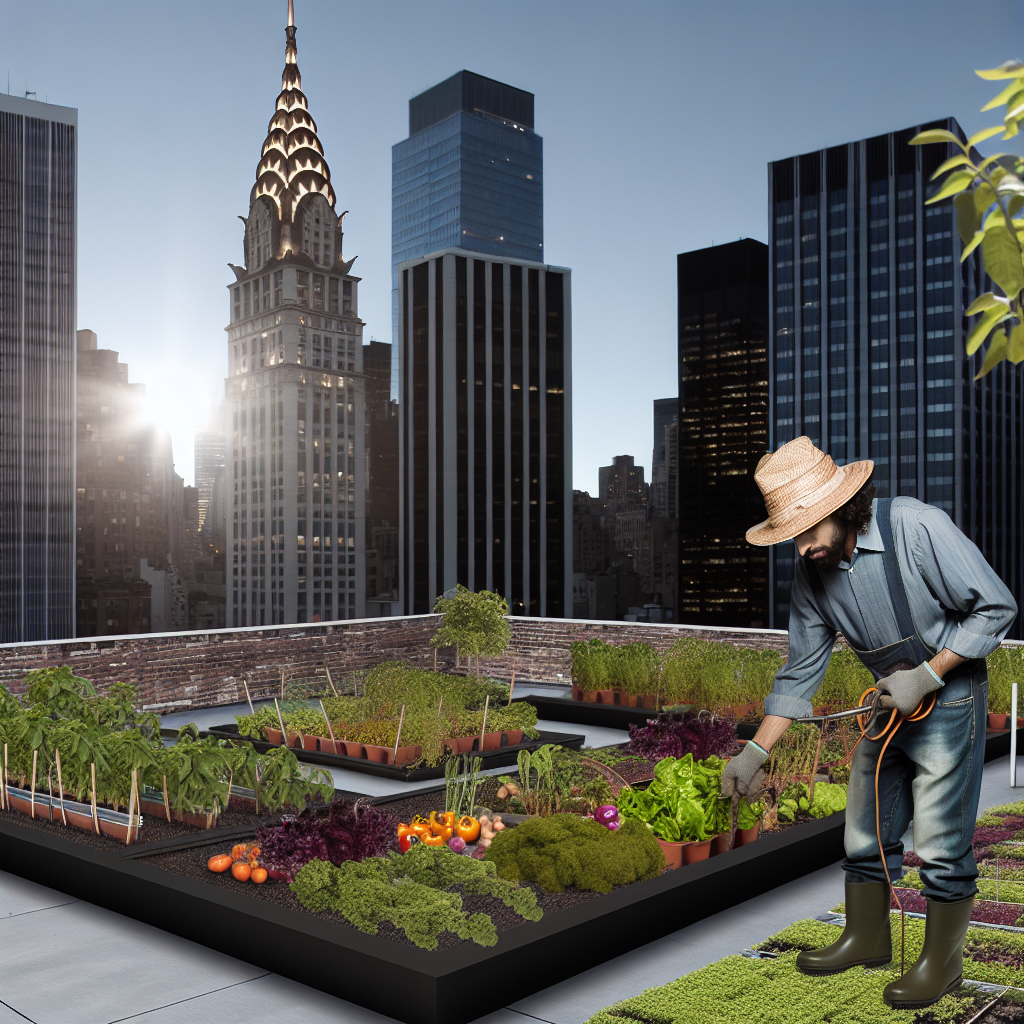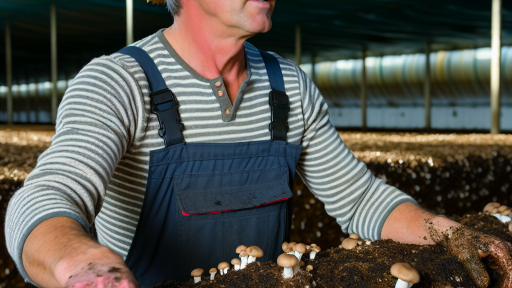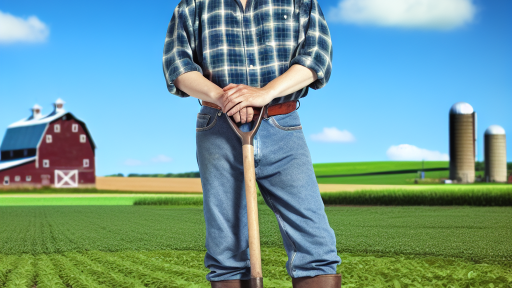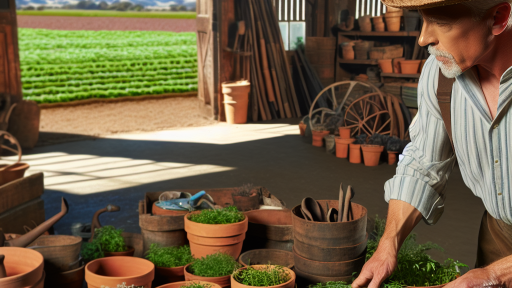Introduction to Urban Vegetable Gardening
Benefits of Urban Gardening
Urban gardening offers numerous benefits for city dwellers.
It promotes access to fresh vegetables.
Such availability leads to healthier eating habits.
Additionally, urban gardening reduces food miles.
Consequently, it lessens the environmental impact of transporting food.
Urban gardens also enhance biodiversity in cities.
This improvement supports local wildlife populations.
Furthermore, gardening fosters community engagement.
Neighbors often collaborate, building social ties.
Importance of Growing Vegetables in Urban Areas
Growing vegetables in urban areas is vital for sustainability.
It addresses the challenge of food insecurity.
Many urban residents lack access to fresh produce.
This gap can lead to poor nutrition and health issues.
Moreover, urban gardening empowers individuals.
People gain skills and knowledge about food systems.
Transform Your Agribusiness
Unlock your farm's potential with expert advice tailored to your needs. Get actionable steps that drive real results.
Get StartedAs a result, they can make informed dietary choices.
Urban gardens also transform underutilized spaces.
They can turn vacant lots into productive landscapes.
This revitalization improves property values.
Choosing the Right Vegetables for Urban Environments
Evaluate Space Constraints
Urban gardens often face limited space.
Therefore, selecting vegetables that thrive in small areas is essential.
Consider using containers or vertical gardening methods.
These methods maximize your growing area efficiently.
Assess Local Climate
Understanding the local climate is crucial for vegetable selection.
For instance, some vegetables prefer warm weather, while others thrive in cooler temperatures.
Research your area’s climate zones to make informed choices.
This allows you to grow vegetables that will flourish in your environment.
Choose Fast-Growing Varieties
Fast-growing vegetables are ideal for urban settings.
These varieties provide quicker harvests, maximizing food production.
Examples include radishes, lettuce, and herbs.
These plants can grow in various conditions, which suits city life.
Consider Nutritional Value
When selecting vegetables, consider their nutritional benefits.
Opt for vegetables that offer high yields of vitamins and minerals.
For example, spinach and kale provide dense nutritional content.
This choice enhances your urban garden’s value.
Explore Container Gardening
Container gardening opens up new possibilities for urban dwellers.
This method suits those with limited ground space.
Many vegetables, like tomatoes and peppers, grow well in pots.
Container gardening enables mobility and easy management.
Showcase Your Farming Business
Publish your professional farming services profile on our blog for a one-time fee of $200 and reach a dedicated audience of farmers and agribusiness owners.
Publish Your ProfileSelect Disease-Resistant Varieties
Opt for disease-resistant vegetable varieties to reduce risks.
These plants require less maintenance and are more reliable.
Look for seeds labeled as resistant to common pests and diseases.
This choice saves time and effort in your urban garden.
Engage with Local Gardening Communities
Connecting with local gardening communities enhances your knowledge.
These groups often share insights on best practices and suitable vegetables.
Explore social media or community centers for local gardening clubs.
This interaction can provide valuable support and resources.
Container Gardening: Best Practices and Materials
Choosing the Right Containers
Begin by selecting containers that suit your space and plants.
Consider using pots made from clay, plastic, or wood.
Each material has its own unique benefits and drawbacks.
Ensure containers provide good drainage to prevent waterlogging.
Moreover, choose a size that accommodates the mature size of your plants.
Soil Selection
The type of soil is crucial for successful container gardening.
Use a high-quality potting mix specifically designed for containers.
This mix provides adequate aeration and drainage for roots.
Additionally, consider adding organic matter to enhance fertility.
Use compost or well-rotted manure to enrich the soil further.
Watering Techniques
Effective watering is essential for container gardening success.
Containers tend to dry out more quickly than in-ground gardens.
Check the moisture level in the soil regularly.
Water thoroughly until moisture drains from the bottom.
A drip irrigation system can simplify this process.
Choosing the Right Plants
Selecting the appropriate plants is vital for container success.
Start with vegetables that thrive in smaller spaces.
Good choices include cherry tomatoes, lettuce, and radishes.
Consider your climate and how much sunlight your container will receive.
Group plants with similar water and light needs together.
Fertilizing Your Plants
Regular fertilization helps container plants thrive.
Use a balanced, water-soluble fertilizer for best results.
Follow the package instructions for proper application rates.
Consider adding slow-release fertilizers to minimize labor.
Finally, monitor your plants for signs of nutrient deficiencies.
Creating a Suitable Environment
Containers can create unique microclimates for plants.
Place them in locations that receive adequate sunlight.
Consider moving containers based on seasonal light changes.
Additionally, protect containers from strong winds or harsh weather.
Using plant covers can help extend the growing season.
Explore Further: Benefits of Organic Farming for the Environment
Soil Selection and Preparation for Urban Gardens
Choosing the Right Soil
Selecting the appropriate soil is crucial for urban gardening success.
Showcase Your Farming Business
Publish your professional farming services profile on our blog for a one-time fee of $200 and reach a dedicated audience of farmers and agribusiness owners.
Publish Your ProfileLook for soil that retains moisture yet drains well.
Consider using a mix of potting soil and native topsoil.
Additionally, avoid soil that has been contaminated with pollutants.
Test your soil to check for contaminants and nutrient deficiencies.
Improving Soil Quality
Enhancing soil quality boosts plant growth and health.
Add organic matter, such as compost, to enrich the soil.
Compost improves structure and provides essential nutrients.
Incorporate mulch to reduce evaporation and suppress weeds.
Regularly turning the soil aerates it and promotes microbial activity.
Building Raised Beds
Raised beds offer several advantages for urban gardening.
They ensure better drainage and prevent soil compaction.
Select materials like untreated wood or metal for building beds.
Fill raised beds with a custom soil mix tailored to your plants.
This setup allows for easier access and better pest management.
Maintaining Soil Health
Regular maintenance keeps the soil healthy over time.
Rotate crops annually to prevent soil depletion.
Incorporate cover crops during off-seasons to enrich the soil.
Monitor soil pH and nutrient levels regularly for optimal growth.
Use organic fertilizers to maintain balanced nutrient availability.
Find Out More: Perennial Vegetables for Edible Landscapes
Vertical Gardening Techniques
Understanding Vertical Gardening
Vertical gardening utilizes upward-growing spaces effectively.
This technique maximizes limited land and promotes greenery.
Urban dwellers can grow a variety of vegetables vertically.
Choosing the Right Structure
Selecting suitable structures for vertical gardens is crucial.
Common options include trellises, towers, and wall planters.
These structures enhance air circulation and sunlight exposure.
Additionally, they can be made from recycled materials.
Maximizing Space
Utilize vertical space by planting upwards instead of outwards.
Consider stacking planters or using tiered shelves.
Hanging baskets can also add charm and utility.
This maximizes your growing area significantly.
Choosing the Right Plants
Selecting appropriate vegetables is key for success.
Some ideal choices include tomatoes, cucumbers, and peas.
Leafy greens like lettuce and spinach also thrive vertically.
These options offer high yields while saving space.
Plant Care and Maintenance
Maintain regular watering to keep vertical plants healthy.
Monitoring sunlight exposure is equally important.
Fertilizing plays a crucial role in plant development.
Moreover, check for pests to prevent infestations.
Benefits of Vertical Gardening
Vertical gardening promotes efficient land use in cities.
Showcase Your Farming Business
Publish your professional farming services profile on our blog for a one-time fee of $200 and reach a dedicated audience of farmers and agribusiness owners.
Publish Your ProfileIt contributes to urban beautification and air quality improvement.
Additionally, it encourages sustainable practices and food sourcing.
Ultimately, it fosters a deeper connection to nature.
Explore Further: Setting Up A Sustainable Container Farm
Accessing Sunlight: Strategies for Urban Gardeners
The Importance of Sunlight
Sunlight plays a critical role in plant growth.
It enables photosynthesis, allowing plants to thrive.
Urban gardeners must maximize sunlight exposure.
Without adequate sunlight, vegetables struggle to grow.
Identifying Sunlight Areas
Begin by assessing your growing space for sunlight access.
Track sunlight patterns throughout the day.
Note areas that receive the most sunlight.
Use a sun calculator app for accurate readings.
Choosing the Right Plants
Select vegetables that thrive in partial shade if necessary.
Some plants tolerate lower light conditions effectively.
- Leafy greens like spinach and kale
- Root vegetables such as carrots and radishes
- Certain herbs like mint and parsley
Using Vertical Gardening Techniques
Consider vertical gardening to maximize space and light.
Vertical structures facilitate light access to lower plants.
Install shelving or trellises for climbing plants.
Utilize walls and fences to enhance growing areas.
Modifying Your Space
Modify your garden layout to improve sunlight exposure.
Remove any shading obstacles like overhanging branches.
Consider painting fences or walls white to reflect light.
This helps increase light for nearby plants.
Utilizing Container Gardening
Container gardening offers flexibility in positioning plants.
Move containers to maximize sunlight during the day.
Ensure pots have drainage holes to prevent waterlogging.
Choose pots that can absorb and retain heat effectively.
Additional Sunlight Enhancements
Employ reflective materials to enhance sunlight access.
Use mirrors or reflective surfaces around your garden.
Cover the soil with mulch to retain moisture and heat.
Sturdy stakes can help move plants closer to available light.
Uncover the Details: Cost-Effective Methods for Mushroom Production

Irrigation Methods Suitable for Urban Settings
Understanding the Need for Efficient Irrigation
Urban gardening presents unique challenges for irrigation.
Limited space and resources require innovative solutions.
Effective irrigation promotes healthy plants and maximizes yields.
Moreover, conserving water is crucial in densely populated areas.
Drip Irrigation Systems
Drip irrigation efficiently delivers water directly to plant roots.
This system reduces water waste and minimizes evaporation.
Install drip lines to ensure consistent moisture levels.
Additionally, automate timers to simplify the watering process.
Advantages of Drip Irrigation
- Reduces water usage by up to 70%.
- Prevents weed growth due to targeted watering.
- Enhances plant growth through consistent hydration.
Soaker Hoses
Soaker hoses offer a straightforward irrigation option for urban gardens.
Showcase Your Farming Business
Publish your professional farming services profile on our blog for a one-time fee of $200 and reach a dedicated audience of farmers and agribusiness owners.
Publish Your ProfileThey allow water to seep out slowly along the length of the hose.
Place them on the soil surface or bury them under mulch.
This method promotes deep root development in plants.
Benefits of Soaker Hoses
- Efficiently waters large garden areas.
- Reduces evaporation compared to traditional watering.
- Simplifies installation and maintenance.
Sprinkler Systems
Sprinkler systems can cover larger areas effectively.
However, they require careful planning to avoid overspray.
Use oscillating or stationary sprinklers for targeted watering.
Timing is essential to maximize efficiency and minimize waste.
Features of Sprinkler Systems
- Available in various types for different garden layouts.
- Can be automated with timers for ease of use.
- Flexible design for seasonal planting variations.
Rainwater Harvesting
Collecting rainwater is an eco-friendly irrigation solution.
Install rain barrels to store water for dry periods.
This practice not only conserves resources but also saves money.
Furthermore, rainwater is typically free of chemicals found in tap water.
Setting Up Rainwater Harvesting
- Position barrels under downspouts for easy collection.
- Ensure proper filtration to prevent debris buildup.
- Utilize gravity-fed systems for efficient water distribution.
Community Gardening: Building Connections and Sharing Resources
Fostering Community Bonds
Community gardening brings neighbors together for a shared purpose.
It strengthens ties among residents in urban neighborhoods.
Through collaboration, individuals foster friendships and create lasting connections.
Moreover, community gardens often become spaces for social gatherings.
Resource Sharing and Accessibility
Sharing resources can significantly reduce the costs of gardening.
Community gardens often provide tools and equipment for members to use.
This collaborative approach allows everyone to participate equally.
Furthermore, it promotes sustainable practices by maximizing available resources.
Educational Opportunities
Community gardens serve as hands-on educational platforms.
Individuals can learn about sustainable gardening techniques and crop rotation.
Workshops often cover topics such as composting and pest management.
Local schools frequently engage in programs that utilize these gardens.
Enhancing Food Security
Community gardens contribute to local food security in urban areas.
They increase access to fresh produce for families with limited resources.
Additionally, surplus food can be donated to local food banks.
This practice enhances community well-being and health.
Encouraging Environmental Stewardship
Participating in community gardens promotes environmental awareness.
Gardening practices often emphasize biodiversity and organic cultivation.
Members learn to appreciate the local ecosystem and its benefits.
Ultimately, community gardens inspire a culture of stewardship.
Pest Management in Urban Gardens
Introduction to Urban Pest Challenges
Pests can quickly become a significant problem in urban vegetable gardens.
Urban environments offer unique challenges for pest management.
These include limited space and high population density.
Understanding Organic Solutions
Organic solutions promote eco-friendly practices in your garden.
Natural predators can help maintain a healthy balance.
Encouraging ladybugs and lacewings will reduce aphid populations.
Utilizing Companion Planting
Companion planting effectively deters pests and boosts growth.
Certain plants naturally repel troublesome insects.
For example, marigolds can deter nematodes in the soil.
Showcase Your Farming Business
Publish your professional farming services profile on our blog for a one-time fee of $200 and reach a dedicated audience of farmers and agribusiness owners.
Publish Your ProfileBasil planted with tomatoes reduces hornworm infestations.
Implementing Physical Barriers
Physical barriers can protect crops from pests.
Row covers provide a shield against flying insects.
Netting or mesh can prevent birds from eating fruits.
Natural Repellents and Homemade Solutions
Natural repellents can complement your pest management strategy.
Garlic sprays effectively deter many pests.
Cayenne pepper mixed with water acts as a natural insect repellent.
Monitoring and Early Detection
Regular monitoring helps catch pest problems early.
Inspect plants frequently for signs of pests or damage.
Quick action can prevent larger infestations down the line.
Community and Resource Sharing
Engaging with your community can enhance pest management efforts.
Community gardens often share resources and experiences.
Local workshops can provide valuable tips and strategies.
Organic and Sustainable Practices for Gardens
Implementing these organic and sustainable strategies is vital.
Not only do they protect your crops, but they also help the environment.
With patience and care, you can maintain a thriving urban garden.
Seasonal Planting Guides
Spring Planting
Spring marks the beginning of the gardening season for urban vegetable crops.
Start planting cool-season vegetables like lettuce and spinach in early March.
By mid-April, you can add beets and carrots to your garden.
As temperatures rise, consider transplanting tomatoes and peppers in late May.
Summer Planting
Summer offers an opportunity to grow heat-loving vegetables.
In June, plant beans and cucumbers for a mid-summer harvest.
August is ideal for sowing fall crops like kale and radishes.
Look for heat-tolerant varieties to thrive in urban heat islands.
Fall Planting
Fall allows urban gardeners to extend their growing season.
In September, plant garlic for an early summer harvest next year.
Additionally, consider sowing cover crops to enrich your soil over winter.
Use row covers to protect late crops from early frost.
Winter Preparation
During winter, prepare for the upcoming planting season.
Plan your crop rotation and select varieties suited for your climate.
Start seedlings indoors in late January for an early spring start.
Utilize containers or cold frames to protect tender plants from frost.
Additional Resources
Small Space Vegetable Gardening | Grow Vertical | joegardener®
Modern Small-Scale Farming – Could it Sustain us? Could we …




